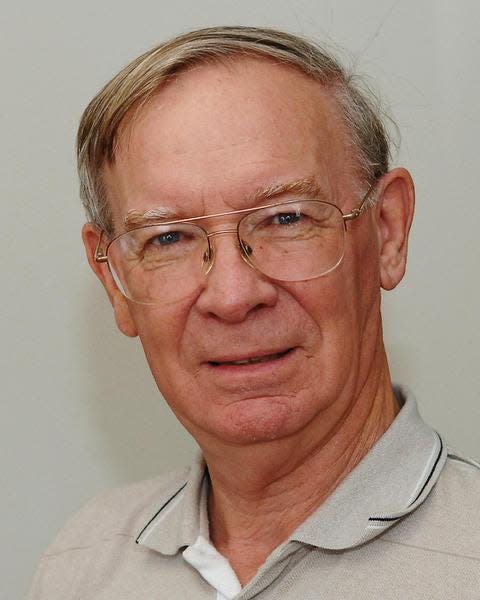Meet Delaware's 'Census Taker of the Sky' and learn how she was inspired by 'great comet'
- Oops!Something went wrong.Please try again later.
“The great comet," the Milford Chronicle reported on Sept. 23, 1882, “which has this week blazed out in the heavens of the Northern Hemisphere has awakened extraordinary interest among astronomers.” One of these interested astronomers was a teenage college student from Dover, Annie Jump Cannon.
Mother inspired Annie Jump Cannon's interest in science
The Dover native’s parents were Wilson Lee Cannon and Mary Elizabeth Jump. Her father was a prominent ship builder, banker and politician.
At the beginning of the Civil War, Wilson Cannon declined to join his Democratic colleagues when he refused to join them in an effort for Delaware to join the Confederacy. Annie’s father appears to have had little interest in science. On the other hand, her mother, who attended a Friend’s school, where she took a course in astronomy, encouraged Annie to study the stars.

Before the advent of electric lights that polluted the night sky with ambient light, Delaware skies were a canopy of a black starlit sky, the Milky Way sparkled in all of its glory, and the streets of Dover, Lewes and other towns were bathed in the soft light of the moon. Annie and her mother built a make-shift observatory at their Dover home.
Entering through a trap door in the attic, the observatory was lit by a single tallow candle that was bright enough to make their way around, but dim enough so as not to interfere with their vision of the stars. Annie once remarked, “Father was more interested in the safety of the house than the movements of the stars.”
Get your OC Air Show tickets: OC Air Show tickets are on sale now. Where to get them, with big savings if you act fast
From Wellesley College to a long career in astronomy
By the time she left Dover in 1880 to attend Wellesley College in Massachusetts, Cannon was well-versed in astronomy. She had taught herself the constellations from crude charts in an old astronomical book, probably one that her mother had used at Friends.
Reporting on her long career in astronomy, the Smyrna Times noted on Feb. 13, 1929, “As the college at that time had no observatory, she conducted her own examinations of the star lands from the porch of old College Hall, and in 1882 was thrilled by the fleeting visit of the comet of that year.” The comet was easily visible with the naked eye, and astronomers across the country tracked its path across the sky.
Two years later, Cannon graduated from Wellesley as the valedictorian of her class. She returned home to Dover, where she pursued her other interest, photography. In 1893, she published a souvenir book of her photographs from the Chicago World Fair.
Latest on bridge collapse: Bridge collapse: Limited channel opens near port. Senate committee passes emergency bill.
A new job at Harvard as a woman 'computer'
A year later, her mother passed away, and Annie returned to Wellesley as junior physics teacher. Shortly afterwards, she was hired by the Harvard College Observatory as one of women “computers,” similar to the human computers depicted in the movie “Hidden Figures.”
The women computers at Harvard worked on classifying the stars using photographs of the heavens. With her background in photography and astronomy, Cannon excelled, and the Smyrna Times reported, “In 1911 she was invited to become curator of photographic plates at the Harvard observatory. At that time there were 300,000 plates, a history of thirty-five years of photographic study of the heavens. [She] then began the most ambitious catalog of the stars that has ever been undertaken, beginning with the stars that were bright enough to show spectra on the photographic plates, covering the whole sky from the South to the North Pole.”
After developing a system of classification of the stars based on temperature of the stars, Cannon personally classified over 350,00 stars to earn her the nickname, “Census Taker of the Sky.” In recognition of her groundbreaking work, Cannon received several honorary doctoral degrees, and in 1923, the Leaue of Women Voters named her as one of the 12 greatest living women in America. Although she officially retired in1940, the Dover native continued to work in the Harvard College Observatory until the “Census Taker of the Sky” passed away in 1941.
Beaches entertainment slate: Celebrate craft beer, mac & cheese and BBQ at Ocean City's Seacrets this weekend
Principal sources
Milford Chronicle, September 23, 1882; April 18, 1941.
Smyrna Times, February, 13 1929; February 15, 1905.
Paul Sutter, “How human ‘computers’' Annie Jump Cannon and Henrietta Swan Leavitt revolutionized astronomy,” Space.Com, June 27, 2023, https://www.space.com/annie-jump-cannon-henrietta-swan-leavitt-revolutionized-astronomy.
Kerri Lee Alexander “Annie Jump Cannon, 1863-1941,” National Women’s History Museum, Annie Jump Cannon Biography (womenshistory.org)
This article originally appeared on Salisbury Daily Times: How Delaware's 'Census Taker of the Sky' was inspired by 'great comet'
